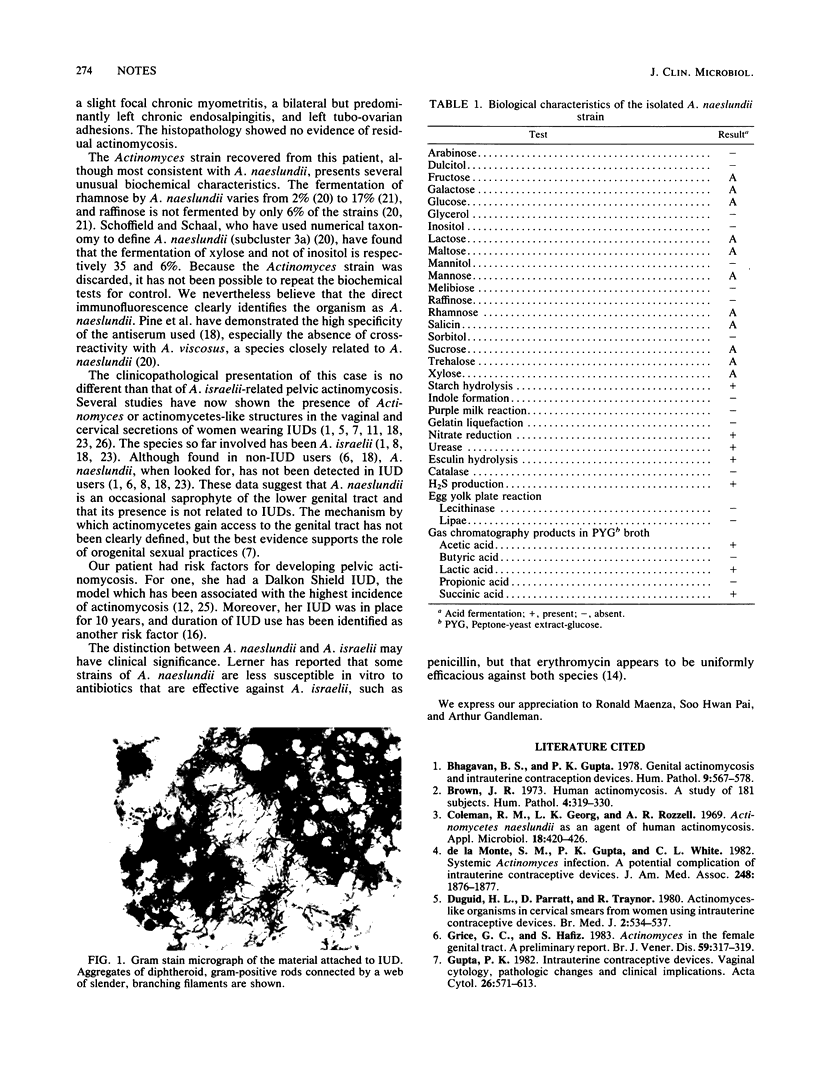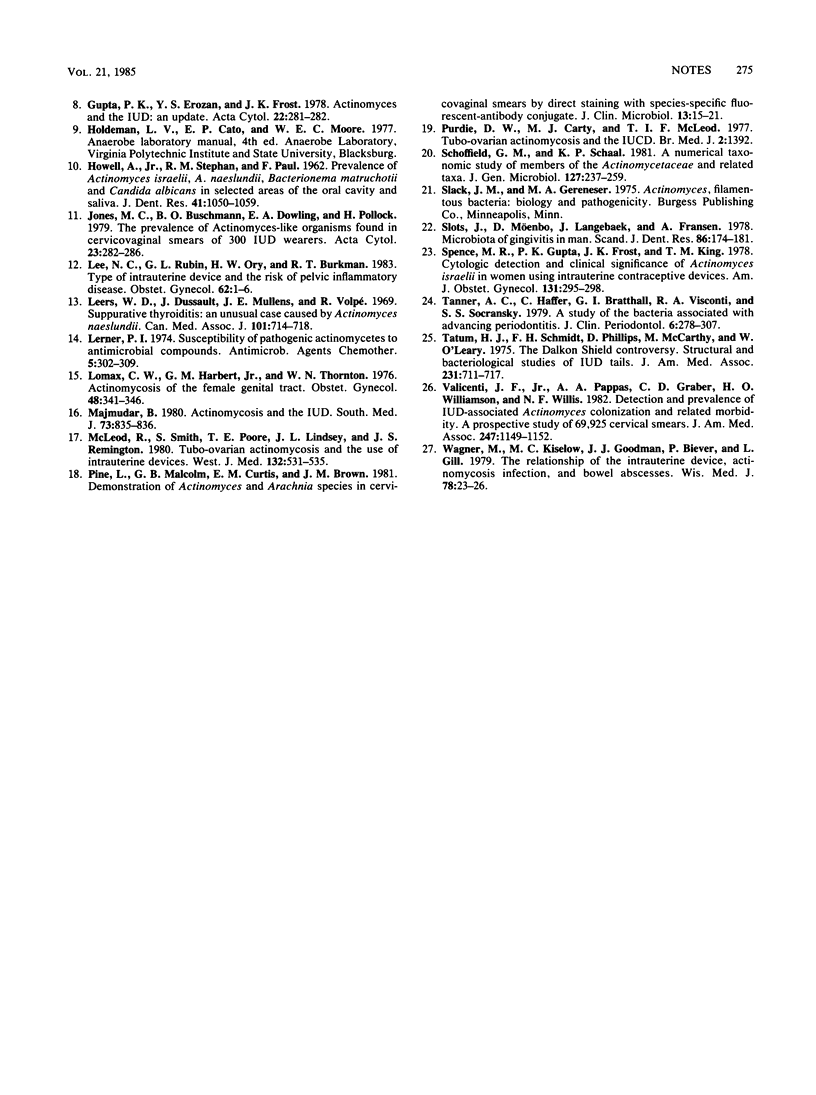Abstract
Actinomyces naeslundii is a saprophyte, sometimes a pathogen, of the human oral cavity. Very few extra-oral infections related to this agent have been described. We report the first instance of A. naeslundii as an etiological agent of pelvic actinomycosis in a user of an intrauterine device, an infection so far exclusively attributed to Actinomyces israelii.
Full text
PDF


Images in this article
Selected References
These references are in PubMed. This may not be the complete list of references from this article.
- Bhagavan B. S., Gupta P. K. Genital actinomycosis and intrauterine contraceptive devices. Cytopathologic diagnosis and clinical significance. Hum Pathol. 1978 Sep;9(5):567–578. doi: 10.1016/s0046-8177(78)80137-3. [DOI] [PubMed] [Google Scholar]
- Brown J. R. Human actinomycosis. A study of 181 subjects. Hum Pathol. 1973 Sep;4(3):319–330. doi: 10.1016/s0046-8177(73)80097-8. [DOI] [PubMed] [Google Scholar]
- Coleman R. M., Georg L. K., Rozzell A. R. Actinomyces naeslundii as an agent of human actinomycosis. Appl Microbiol. 1969 Sep;18(3):420–426. doi: 10.1128/am.18.3.420-426.1969. [DOI] [PMC free article] [PubMed] [Google Scholar]
- Duguid H. L., Parratt D., Traynor R. Actinomyces-like organisms in cervical smears from women using intrauterine contraceptive devices. Br Med J. 1980 Aug 23;281(6239):534–537. doi: 10.1136/bmj.281.6239.534. [DOI] [PMC free article] [PubMed] [Google Scholar]
- Grice G. C., Hafiz S. Actinomyces in the female genital tract. A preliminary report. Br J Vener Dis. 1983 Oct;59(5):317–319. doi: 10.1136/sti.59.5.317. [DOI] [PMC free article] [PubMed] [Google Scholar]
- Gupta P. K., Erozan Y. S., Frost J. K. Actinomycetes and the IUD: an update. Acta Cytol. 1978 Sep-Oct;22(5):281–282. [PubMed] [Google Scholar]
- Gupta P. K. Intrauterine contraceptive devices: vaginal cytology, pathologic changes and clinical implications. Acta Cytol. 1982 Sep-Oct;26(5):571–613. [PubMed] [Google Scholar]
- HOWELL A., Jr, STEPHAN R. M., PAUL F. Prevalence of Actin-omyces israelii, A. naeslundii, Bacterionema matruchotii, and Candida albicans in selected areas of the oral cavity and saliva. J Dent Res. 1962 Sep-Oct;41:1050–1059. doi: 10.1177/00220345620410050701. [DOI] [PubMed] [Google Scholar]
- Jones M. C., Buschmann B. O., Dowling E. A., Pollock H. M. The prevalence of actinomycetes-like organisms found in cervicovaginal smears of 300 IUD wearers. Acta Cytol. 1979 Jul-Aug;23(4):282–286. [PubMed] [Google Scholar]
- Lee N. C., Rubin G. L., Ory H. W., Burkman R. T. Type of intrauterine device and the risk of pelvic inflammatory disease. Obstet Gynecol. 1983 Jul;62(1):1–6. [PubMed] [Google Scholar]
- Lerner P. I. Susceptibility of pathogenic actinomycetes to antimicrobial compounds. Antimicrob Agents Chemother. 1974 Mar;5(3):302–309. doi: 10.1128/aac.5.3.302. [DOI] [PMC free article] [PubMed] [Google Scholar]
- Lomax C. W., Harbert G. M., Jr, Thornton W. N., Jr Actinomycosis of the female genital tract. Obstet Gynecol. 1976 Sep;48(3):341–346. [PubMed] [Google Scholar]
- Majmudar B. Actinomycosis and the IUD: infection underdiagnosed. South Med J. 1980 Jul;73(7):835–836. [PubMed] [Google Scholar]
- McLeod R., Smith S., Poore T. E., Lindsey J. L., Remington J. S. Tubo-ovarian Actinomycosis and the Use of Intrauterine Devices. West J Med. 1980 Jun;132(6):531–535. [PMC free article] [PubMed] [Google Scholar]
- Pine L., Malcolm G. B., Curtis E. M., Brown J. M. Demonstration of Actinomyces and Arachnia species in cervicovaginal smears by direct staining with species-specific fluorescent-antibody conjugate. J Clin Microbiol. 1981 Jan;13(1):15–21. doi: 10.1128/jcm.13.1.15-21.1981. [DOI] [PMC free article] [PubMed] [Google Scholar]
- Purdie D. W., Carty M. J., McLeod T. I. Tubo-ovarian actinomycosis and the IUCD. Br Med J. 1977 Nov 26;2(6099):1392–1392. doi: 10.1136/bmj.2.6099.1392. [DOI] [PMC free article] [PubMed] [Google Scholar]
- Schofield G. M., Schaal K. P. A numerical taxonomic study of members of the Actinomycetaceae and related taxa. J Gen Microbiol. 1981 Dec;127(2):237–259. doi: 10.1099/00221287-127-2-237. [DOI] [PubMed] [Google Scholar]
- Slots J., Möenbo D., Langebaek J., Frandsen A. Microbiota of gingivitis in man. Scand J Dent Res. 1978 May;86(3):174–181. doi: 10.1111/j.1600-0722.1978.tb01929.x. [DOI] [PubMed] [Google Scholar]
- Spence M. R., Gupta P. K., Frost J. K., King T. M. Cytologic detection and clinical significance of Actinomyces israelii in women using intrauterine contraceptive devices. Am J Obstet Gynecol. 1978 Jun 1;131(3):295–298. doi: 10.1016/0002-9378(78)90604-x. [DOI] [PubMed] [Google Scholar]
- Tanner A. C., Haffer C., Bratthall G. T., Visconti R. A., Socransky S. S. A study of the bacteria associated with advancing periodontitis in man. J Clin Periodontol. 1979 Oct;6(5):278–307. doi: 10.1111/j.1600-051x.1979.tb01931.x. [DOI] [PubMed] [Google Scholar]
- Tatum H. J., Schmidt F. H., Phillips D., McCarty M., O'Leary W. M. The Dalkon Shield controversy. Structural and bacteriological studies of IUD tails. JAMA. 1975 Feb 17;231(7):711–717. doi: 10.1001/jama.231.7.711. [DOI] [PubMed] [Google Scholar]
- Valicenti J. F., Jr, Pappas A. A., Graber C. D., Williamson H. O., Willis N. F. Detection and prevalence of IUD-associated Actinomyces colonization and related morbidity. A prospective study of 69,925 cervical smears. JAMA. 1982 Feb 26;247(8):1149–1152. [PubMed] [Google Scholar]
- Wagner M., Kiselow M. C., Goodman J. J., Biever P., Gill L. The relationship of the intrauterine device, actinomycosis infection, and bowel abscesses. Wis Med J. 1979 May;78(5):23–26. [PubMed] [Google Scholar]
- de la Monte S. M., Gupta P. K., White C. L., 3rd Systemic Actinomyces infection. A potential complication of intrauterine contraceptive devices. JAMA. 1982 Oct 15;248(15):1876–1877. doi: 10.1001/jama.248.15.1876. [DOI] [PubMed] [Google Scholar]



